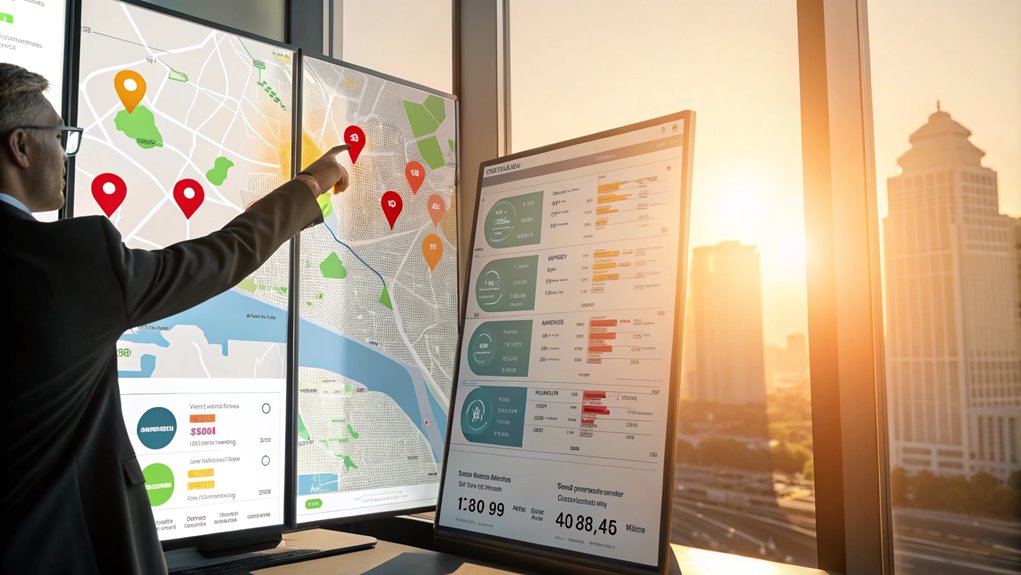To maximize ROI by combining PPC and local SEO, you’ll need to align your keywords, content, and targeting strategies across both channels. Start by using Google Keyword Planner to identify high-intent local keywords, then create location-specific landing pages optimized for both paid and organic traffic. Implement mobile-responsive design, integrate local schema markup, and showcase customer reviews to boost credibility. With 46% of Google searches having local intent and 75% of local searches resulting in store visits, you’ll want to track performance metrics closely and adjust your budget allocation based on data-driven insights. The following strategies will help you capture both immediate and long-term local market opportunities.

In today’s digital marketplace, understanding the local search landscape is paramount for any business looking to capture nearby customers.
The data clearly shows the massive local impact of search behavior, with 46% of Google searches having local intent and 97% of users searching online to find local businesses. The conversion rates are particularly striking – 75% of local searches result in either a store visit or phone call. With approximately 3.5 billion searches performed on Google daily, the opportunity for local visibility is enormous.
You can’t ignore the mobile revolution in local search. With 57% of local searches occurring on mobile devices and “near me” searches growing by 400% globally, consumer behavior has shifted dramatically. Google Maps now ranks as the fourth most popular smartphone app, highlighting its crucial role in local search. Maintaining NAP consistency across all platforms has become essential for improving local search rankings.
Your potential customers are actively seeking local solutions, with 78% of local mobile searches leading to offline purchases and 88% resulting in business contact within 24 hours.
The search intent behind local queries is clear: people are ready to act. When users conduct local searches, 28% make a purchase within 24 hours, and 72% shop within their local area.
If you’re not visible online, you’re missing out – 62% of consumers will dismiss businesses they can’t find through search.
To maximize your digital marketing impact, you’ll need to conduct thorough keyword research that targets both paid and organic search channels simultaneously.
Your research should focus on identifying high-intent local keywords with manageable competition levels while analyzing search volumes and commercial intent through tools like Google Keyword Planner. Tracking lead metrics is essential to measure the success of your keyword optimization efforts. Implementing long-tail location-specific keywords will drive more targeted traffic to your campaigns. Consider utilizing themed keyword groups to better organize and manage your local search terms.
Once you’ve identified your target keywords, optimize your landing pages with consistent, relevant content that aligns with both your PPC ads and organic search strategy.
Successful keyword alignment across PPC and local SEO campaigns demands a strategic approach to research and implementation.
Start by leveraging tools like Google Keyword Planner and SEMrush’s Keyword Magic Tool to gather local insights that’ll inform both your paid and organic strategies. Track metrics like search volume and CPC to determine the most valuable keywords for your campaigns. Create a holistic keyword mapping system that connects location-specific terms with your core service offerings.
Focus on understanding search intent and prioritize keywords with lower difficulty scores (KD% 0-49%) to maximize your chances of ranking while optimizing ad spend. Consider that 80% of consumers conduct local business searches multiple times per week, making local keyword optimization crucial for visibility. Building a strong online presence is essential for dental practices in competitive markets.
Combine explicit location modifiers like city names and neighborhoods with implicit terms such as “near me” and “local” to capture both traditional and voice search traffic.
Utilize autosuggest features and SERP analysis to identify high-performing keywords that work across both channels.
Monitor and analyze performance regularly, adjusting your strategy based on real-time data.
Create dedicated location pages that incorporate your researched keywords naturally, and confirm they’re optimized for both paid and organic visibility.
Remember to include question-based keywords in your content strategy to capture informational searches while maintaining consistent messaging across PPC ads and organic content.
Landing page optimization demands a synchronized approach between PPC and local SEO efforts to maximize ROI across both channels.
Through strategic alignment of your content, you’ll create landing pages that serve both paid and organic search objectives while maintaining content precision across all touchpoints.
To optimize effectively, start by analyzing your PPC performance data to identify high-converting keywords and compelling ad copy elements. Incorporate these insights into your landing page content, ensuring consistency between your paid ads and organic search presence.
You’ll want to maintain keyword consistency while avoiding cannibalization by carefully selecting which terms to target through each channel.
Focus on creating locally-relevant content that resonates with your target audience, using PPC geo-targeting data to inform your local SEO strategy. Pay special attention to user experience metrics from both channels, as these insights can help you refine page layouts and content structure.
Use your PPC conversion data to optimize call-to-actions and value propositions that work equally well for organic traffic.
Remember to integrate your keyword strategy across both channels while maintaining distinct landing pages when necessary to prevent content duplication and preserve quality scores.
Consider implementing predictive analytics to forecast campaign performance and optimize your PPC and SEO strategies accordingly.

When optimizing landing pages for both PPC and local SEO, you’ll need to focus on three critical elements: compelling headlines, clear calls-to-action, and trust-building local signals such as reviews and location-specific content.
Your mobile-first design strategy must prioritize fast loading speeds, intuitive navigation, and thumb-friendly button placement to capture the growing segment of local searchers on smartphones.
You can strengthen your local presence by incorporating location-specific schema markup, embedding Google Maps, and displaying prominent contact information that matches your Google Business Profile.
Implementing Seraphinite Accelerator technology can significantly boost your landing page performance and user engagement through enhanced loading speeds.
Effectively combining PPC and local SEO requires meticulously optimized landing pages that serve as powerful conversion tools. Your page elements must align with both paid search objectives and organic search requirements, while your content strategy should focus on delivering value to local audiences.
To maximize your landing pages’ effectiveness, you’ll need to integrate technical optimization with compelling content and local-specific elements. Confirm your pages load quickly, feature mobile-responsive designs, and incorporate clear calls-to-action that drive conversions. Establishing user-friendly website design helps retain visitors and improve overall engagement rates.
| Element | PPC Focus | Local SEO Impact |
|---|---|---|
| Content | Keyword-rich ad copy | Geographic terms |
| Technical | Fast loading speed | Mobile optimization |
| Analytics | Conversion tracking | Local ranking data |
Monitor your landing page performance through detailed analytics and tracking systems. You’ll want to regularly conduct A/B tests to refine page elements and improve conversion rates. Remember to maintain consistency between your PPC ads and landing pages while incorporating local SEO elements like location-specific keywords and content. By focusing on these key components, you’ll create landing pages that effectively serve both your paid and organic search efforts while driving meaningful results in your target market.
A mobile-first approach to landing page design has become essential in today’s digital landscape, with over half of mobile users abandoning pages that take more than 3 seconds to load. To maximize your PPC and local SEO efforts, you’ll need to prioritize mobile experiences that drive conversions and engagement.
Start by implementing core design principles that focus on simplicity and user-centric navigation. Keep your content concise, use high-quality compressed images, and position CTAs strategically above the fold where they’re easily accessible.
Your landing pages should adapt seamlessly to different screen sizes while maintaining a clean, uncluttered layout that enhances user engagement.
To optimize performance, regularly test your pages using tools like Google PageSpeed Insights and conduct A/B testing to refine your approach. Consider successful examples like Nori and Brooklinen, which demonstrate how personalized experiences and minimal designs can drive conversions.
Remember to tailor your content specifically for mobile users, incorporating high-contrast elements and intuitive navigation. By focusing on speed optimization and frictionless user experiences, you’ll create landing pages that effectively convert PPC traffic while supporting your local SEO goals.
Through strategic implementation of local trust signals, your landing pages can establish immediate credibility while boosting both PPC performance and local search visibility. By incorporating trust elements strategically, you’ll create a powerful foundation that serves both your paid and organic search efforts.
Start by showcasing your local expertise through customer testimonials, reviews, and case studies specific to your service area. Implement schema markup to help search engines understand your local context, and maintain consistent NAP information across all landing pages.
Display trust badges, industry certifications, and local awards prominently to reinforce your authority. Strengthen your local signals by embedding Google Maps, using location-specific imagery, and highlighting community involvement through local events and partnerships.
Create an FAQ section that addresses location-specific concerns, and feature geo-targeted offers that resonate with your local audience. Don’t forget to incorporate high-quality visuals of your physical location, team members, and completed local projects to build authentic connections with potential customers.
These trust elements work together to improve quality scores for PPC campaigns while simultaneously enhancing your local SEO performance.
Ensure your landing pages maintain mobile responsiveness to maximize accessibility and user engagement across all devices.
Customer reviews serve as powerful catalysts for integrating PPC and local SEO strategies, creating a synergistic effect that amplifies both paid and organic search visibility.
By analyzing review insights and customer feedback, you’ll identify valuable keywords and messaging that can strengthen both your paid campaigns and local search presence simultaneously.
You can maximize this integration by incorporating review extensions in your PPC ads while actively managing your Google My Business listings.
When you respond to reviews promptly and professionally, you’re not only improving your local SEO rankings but also enhancing the credibility of your paid advertisements. This dual-impact approach creates a stronger overall digital presence.
Focus on generating high-quality reviews rather than just quantity, as meaningful testimonials will drive better results across both channels.
Use real-time review data to optimize your PPC campaigns while leveraging the same information to enhance your local SEO content.
By developing a cohesive review strategy that aligns your paid and organic efforts, you’ll create a more trustworthy brand presence that resonates with potential customers.
Remember to consistently analyze review analytics to refine your targeting and improve both PPC performance and local search rankings.

Building on the power of customer reviews, strategic geographic targeting combines the precision of PPC with local SEO to reach your most valuable audiences. To achieve local dominance, you’ll need to leverage both Google Ads’ location targeting capabilities and robust local SEO practices simultaneously.
Start by setting up targeted PPC campaigns that focus on specific geographic areas using radius targeting and location-specific keywords. You can target up to 1000 locations while excluding areas that don’t serve your business interests.
Create dedicated landing pages for each location, complete with local addresses, phone numbers, and relevant content that demonstrates your geo penetration strategy.
Strengthen your local presence by optimizing your Google My Business listings and securing citations through platforms like Yext. Use schema markup on your landing pages to help search engines understand your local relevance.
Link these efforts with your PPC campaigns by maintaining consistent contact information and messaging across all platforms. Monitor both your PPC metrics and local SEO rankings regularly, making data-driven adjustments to optimize performance and maximize ROI in each geographic area you’re targeting.
While implementing local SEO and PPC strategies is pivotal, measuring their effectiveness determines your success in the digital marketplace. You’ll need to track specific performance metrics across both channels to optimize your campaigns and maximize ROI.
Start by setting up Google Analytics and Search Console to monitor your organic traffic, user behavior, and conversion rates. Track local keyword rankings and analyze how your website performs in specific geographic locations.
Don’t forget to monitor your Google My Business insights for valuable data on customer interactions and engagement.
For holistic analytics insights, utilize specialized tools like SEMrush or Ahrefs to conduct competitor analysis and identify new opportunities. Track your local citations using platforms like Moz Local or BrightLocal, ensuring your NAP information remains consistent across all directories.
Measure the impact of your positive reviews and their correlation with ranking improvements.
You’ll want to regularly assess your conversion tracking data, focusing on how local searches contribute to your business goals. Compare your PPC and organic search performance metrics to identify areas where these channels complement each other, and adjust your strategy accordingly based on the data-driven insights you gather.

To maximize the impact of your combined PPC and local SEO efforts, you’ll need to strategically allocate your marketing budget across multiple channels and campaigns.
Start by dedicating 40-60% of your PPC budget to high-performing platforms where your target audience is most active, while reserving 20-30% for testing new strategies and platforms.
Your spend strategy should include allocating at least 25% of your PPC budget toward SEO initiatives, with $10,000-$15,000+ monthly investment for high-quality SEO expertise.
When implementing budget optimization, analyze your local market’s average cost-per-click and conduct thorough keyword research to identify high-intent, location-specific terms.
Set up a dynamic budget allocation system that allows you to adjust spending based on performance metrics. Use daily and monthly budgets for ongoing campaigns while implementing campaign-level budgets for specific initiatives.
Monitor ROI closely and shift funds from underperforming areas to those generating better returns. Regular budget reviews are essential – analyze your performance data, adjust geographic targeting, and reallocate resources to maintain peak results across both your PPC and SEO efforts.
A robust Quality Score serves as the cornerstone of successful PPC campaigns, directly impacting your ad placement and cost-per-click rates. By integrating local SEO practices with your PPC strategy, you’ll strengthen pivotal quality signals and achieve better ad performance.
| Element | Integration Strategy |
|---|---|
| Keyword Alignment | Use local SEO insights to enhance PPC keyword relevance |
| Landing Pages | Optimize for mobile and incorporate location-specific content |
| User Experience | Implement clear navigation and consistent brand messaging |
| Analytics | Leverage cross-channel data for strategy refinement |
Focus on creating landing pages that seamlessly align with your ad copy while incorporating local SEO elements. You’ll want to guarantee your content addresses specific geographic needs and maintains consistency across all touchpoints. By analyzing performance data from both channels, you can identify high-performing keywords and user behavior patterns.
Remember to regularly update your content and maintain accurate location information to improve relevance. Implement clear calls-to-action and guarantee mobile optimization to enhance user experience. This integrated approach not only boosts your Quality Score but also creates a more effective overall digital marketing presence that resonates with your local audience.
By combining PPC and local SEO strategically, you’ll create a powerful synergy that maximizes your ROI. Focus on aligning your keyword strategy, optimizing landing pages, and leveraging customer reviews across both channels. Monitor your metrics closely and adjust your budget allocation based on performance data. With proper geographic targeting and continuous improvement of your Ad Quality Score, you’ll drive better results while optimizing your marketing spend.
Providing comprehensive brand solutions from website development to all things local marketing